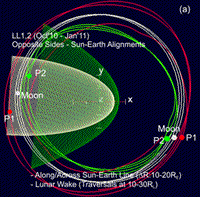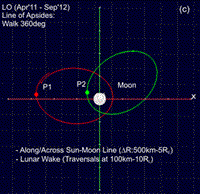Orbits
ARTEMIS Mission Phase Orbit Configurations:
| Stage 0 | Stage 1 | Stage 2 | Stage 3 | Stage 4 | LADEE Conjuctions |
ARTEMIS Orbit Parameters:
- Low Periapses 8/2011 - 12/2012: Probe P1 (TH-B) Probe P2 (TH-C)
- Magnetic Anomalies
- Lunar Wake Crossings 11/2011 - 12/2012: Probe P1 (TH-B) Probe P2 (TH-C)
- Fast Survey Times 1/20/2010 - 11/20/2011: Probe P1 (TH-B) Probe P2 (TH-C)
The different orbit configurations define the five stages of the mission:
THEMIS orbits in X-Y Geocentric Solar Magnetospheric (GSM) coordinates during the 3rd year of the operations (2010) in the absence of orbit- raising maneuvers for P1, P2. Differential precession of the line of apsides prevents conjunctions between probes along the Earth's magnetotail. In addition, long Earth shadows in March 2010 (not shown) would have presented a problem to mission safety. The ARTEMIS mission raised the apogees of P1 and P2 such that they were captured into lunar orbits, resulting in new science from the lunar environment.
THEMIS P1 (TH-B) in red and P2 (TH-C) orbit between this summer's orbit raise maneuvers and October 2010 when they were captured by the Lagrange points between Earth and Moon. After six months in those orbits, P1 and P2 will be inserted into Lunar orbits where they will make measurements of the Lunar wake, the magnetotail, and the solar wind through September 2012.
ARTEMIS orbits in the first 3 months of science operations: P1 and P2 were on Lunar Lagrange points 1 and 2, i.e., on opposite sides of the Moon, shown here in the GSM coordinate system (same as Figure 1). Shown are two representative inter-probe separation conditions in the magnetosphere (white mesh) and in the solar wind (i.e., outside the shock region represented by the green mesh).
The two probes, P1 and P2, arrived at the Lissajous orbits, on opposite sides of the Moon, on September 1, 2010 (P1, near-side) and October 19, 2010 (P2, far-side), respectively. The insertion of P2 was gradual, such that useful tail and solar wind two-probe conjunctions could commence as early as September 21, 2010. The probes stayed in this configuration until January 8, 2011. In the Lissajous orbits, although the probes hovered ~60,000 km away from the Moon along the Earth-Moon line (on their respective sides of the Moon), they were librating along their orbit-tracks about Earth, +/- 60,000 km ahead of or behind the Moon. This strategy resulted in a variety of P1-P2 conjunctions with inter-probe separations of 60,000-120,000 km (dR ~ 10-20RE, or 35-70RL) that were either along the Sun-Earth line or across it; those conjunctions were either in the solar wind, or in the magnetotail and magnetosheath. This strategy also resulted in six long-range lunar wake crossings by either P1 or P2 from around 20 and 30RL. Figure (a) shows snapshots of two possible relative positions of P1 and P2 in the magnetosphere and the solar wind. This mission phase, which is denoted as Lunar Lagrange points 1 and 2 phase, or "LL1,2", lasted approximately 3 months.
ARTEMIS orbits in the next 3 months of science operations: P1 and P2 were both on Lunar Lagrange point 1, i.e., on the same side of the Moon (the one facing Earth), shown here in the GSM coordinate system. Shown are two representative inter-probe separation conditions inside the magnetosphere (white mesh) and in the solar wind or magnetosheath (i.e., outside the white mesh).
In early January 2011, probe P1 was commanded to leave its Lissajous orbit on the far side and entered orbit into the Lunar Lagrange point 1, or LL1, on the near-side of the Moon. At different phases of their Lissajous orbits, the two probes (P1 and P2) resided at inter-probe separation vectors of size 5-20 RE, with longer ranges preferentially across the Earth-Moon line and shorter ranges along the Sun-Earth line. Figure (b) shows two snapshots of these configurations. Another six lunar crossings were also acquired in this phase, from distances around 10-30RL (most are around 15-20RL); those wake crossings occured typically far upstream of Earth's bow shock and were pristine, i.e., least affected by Earth foreshock effects. This phase lasted another 3 months, until early April, 2011. It is denoted Lunar Lagrange point 1 phase, or "LL1" phase.
Representative ARTEMIS probe locations after lunar orbit insertion, shown in Selenocentric Solar Ecliptic coordinates, with horizontal axis towards the Sun (positive to the right) and vertical axis along the cross product of the ecliptic-normal and the Moon-Sun line (positive upwards).
In early June 2011 P1 was commanded to insert into lunar orbit by performing a series of periselene burn maneuvers; P2 followed suit shortly after. By July 2011 both P1 and P2 were in stable equatorial, high-eccentricity orbits, of ~100 km x 19,000 km altitude. These are stable, 26 hr period orbits with inter-probe separations 500 km-5RE. One probe is in a retrograde and the other in a pro-grade orbit, such that the precession rates of their line of apsides will walk relative to each other by 15-20 degrees per month; in ~2 years the lines of apsides will cover a full circle, resulting in a wide range of inter-probe vectors relative to the Sun-Earth line and lunar wake crossings from a wide range of altitudes. A subset of orbits resulting in simultaneous, two-probe crossings of the lunar wake is also possible during certain mission phases, when one of the two probes is at apoapsis along the Sun-Moon line behind the Moon.
Timeline for planned LADEE mission operations using 2011 baseline lunar science orbit dawn terminator crossings. Conjunctions with LADEE at the dawn terminator necessitate that one of the ARTEMIS probes have its periapsis positioned near the dawn terminator and pass through periapse close to the time of LADEE passage through that region. Each dawn crossing opportunity here actually represents a period of time when 5-15 opportunities for coordinated measurements may occur.












